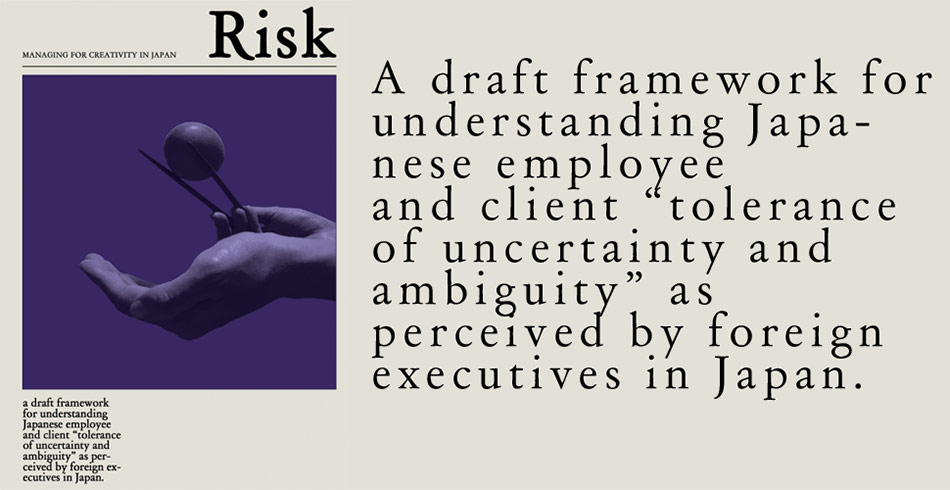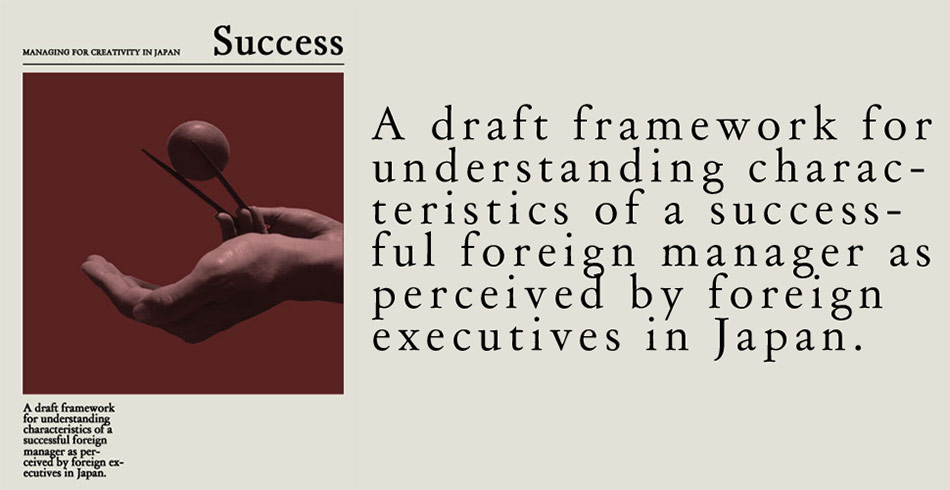Managing for Creativity in Japan Talking with Foreign Executives in Japan
Patterns Tagged ‘Risk’
On Being a Foreign Employer
“….First of all, it’s a risk to work for foreigners. Two, it’s not a safe, established Japanese company…”
Hard to Pinpoint
“….everyone was fascinated with me but not fascinated enough to employ me….”
Be the Template Bringer
“….If you as a manager provide a template or formula and say ‘go for it’, they’ll do a beautiful job…..”
Mid-Level Creativity Killers
“…if you want to offer something which is a bit creative and involves some level of risk then you might find that very frustrating….”
What’s the Reward for Being Creative?
“…What’s the reward for taking a risk in Japan? I don’t know. Are you going to get paid more? Probably not….”
Kaisha vs. Company
“…Everybody has a vested interest in the stability of the system rather than, perhaps, genuine progress….”
Risk, Trust, Experience in the West
“….Whatever you have, whatever experience you have in the West doesn’t really matter, it doesn’t translate….”
Working with Established Models
“…Because they are risk averse they want to work with proven approaches and methods….”
Becoming More Collaborative
“…and you also don’t want to make your clients look bad by knowing more than them…… That’s fatal to creativity….”
A Green Plant in the Desert
“…If you are a green plant in the middle of the desert you are going to die…”
The Weirdo
“..You can’t have him as one of the battery hens, how can you have creativity in that scenario? It’s impossible….”
Focus Groups in Japan
“If you did a focus group in America you’d have 9 or 12 people in the room and some people would ‘love this’ and ‘hate that’ and there’d be big fights and arguments and maybe a couple of people would sit there numb or play with their blackberries or whatever and when it came to […]
Intensive Client Servicing
“The client servicing process in Japan is incredibly intensive. The guys sometimes come into the office after lunch because they’ve been working through to 10 or 11 at night. And our experience is not really that extreme, I think. The client will be on the phone to them constantly the whole day about details, stuff, […]
You always get what you always got
“The old adage “if you always do what you’ve always done then you always get what you always got” is very true in Japan. You get very consistent results, but where does that leave you on the creativity and innovation barometer?” **************************************************** This post is part of a series of excerpts from interviews with foreign […]
The Whole Train Set
“When you are a country manager overseas, you can short-cut a lot of that. If you want to do something that isn’t directly touching the customer, that doesn’t need head office funds, then you don’t really have to have the same degrees of people involved in the decision or have the same formal gateposts. Something […]
Aversion to Change
“People don’t want to take a risk, it’s mendokusai (bothersome) to change things. Another thing that is characteristic of Japan is that once a system is in place then it is very hard to change that system. Everything comes to support the existing system. On the other hand though, you look at a company like […]
Long Tenure
“Many of the employees have worked together for a very long time, between 10 and 20 years and sometimes on the same team. This means that there are old, established interpersonal relationships on the teams, which is increasingly rare in a Western company. Very few westerners would be satisfied in that context. So there is […]
Risk Taking
“Japan isn’t a nation that flies by the seat of its pants is it? I suppose that culturally there is a bit more conservativism here and it’s not as culturally acceptable for things to be random here or thought out at the last minute. People will want security and structure around a creative idea here, […]
Cutting Good Cookies
“Here they tend here to take the cookie cutter and cut the same cookie. It’s a good cookie, I mean once they get the design right its great and I think, as I said, that’s why their products are so great. Because once they design it, it’s designed with that reliability built in. They know […]
Foreigners and Change Management
“Foreigners may have an edge on the change management roles because it is recognized that it is difficult for an internal person to be the nail that sticks up. Sometimes it’s just easier to find people who are willing to come in and go through the learning curve of the organization – there are more […]
Risk Averse Clients
“Clients in Japan don’t generally ask for advice from their suppliers, they generally tell their suppliers what to do and tend to be very prescriptive. They tend to go into great detail about how they want something to be done. The client generally wants to have a very detailed input into everything. I think my […]
Formula Based Creativity
“When you look at art and design, it’s all based on formulas and templates. There is very little Japanese art which isn’t kaizen (incremental improvement). If you study Japanese art like sumi-e or ikebana you will notice that everything is run by rules. It is a very rule-laden culture. In a corporate environment working in […]

